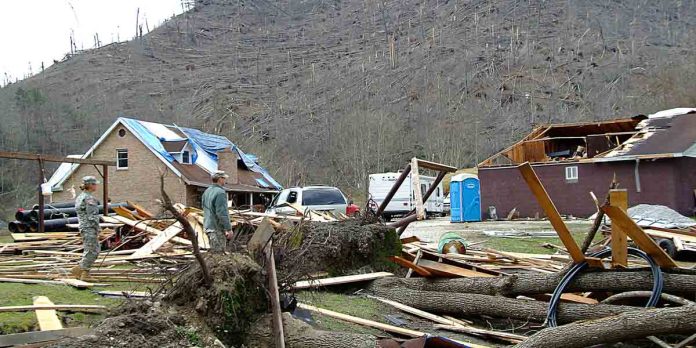West Virginia has a population of over 1.7 million people, many of whom have faced natural disasters or have been compelled to evacuate due to them.
However, many West Virginians are unaware of the variety of natural disasters that can occur in the state.
This article examines the natural disasters common in West Virginia, the most catastrophic disasters in the state since 2000, and guides residents on preparing for such events.
Is West Virginia At Risk of Natural Disasters?
Compared to the rest of the United States, West Virginia has a low risk of natural disasters. Excluding COVID, West Virginia has had 43 disaster declarations since 2000. Of these, 37 were declared major disasters.
West Virginia is also frequently hit by natural disasters, which cause more than $1 billion in damages. Since 2000, more than 21 separate $1-billion events have affected West Virginia. Most of these events were severe storms.
Worst Natural Disasters in West Virginia By Cost (Since 2000)
- Hurricane Sandy 2012: $83.9 billion
- Hurricane Ida 2021: $80.2 billion
- Hurricane Ivan 2004: $32.2 billion
- Spring-Summer 2011 Drought and Heat Wave: $16.2 billion
- Spring-Fall 2002 Drought: $15.1 billion
Worst Natural Disasters in West Virginia By Deaths (Since 2000)
- Hurricane Sandy 2012: 159 deaths
- Hurricane Ida 2021: 96 deaths
- Spring-Summer 2011 Drought and Heat Wave: 95 deaths
- Hurricane Ivan 2004: 57 deaths
- Hurricane Isabel 2003: 55 deaths
*Cost and death tolls are for the entire disaster, including in other states affected.
Most Common Natural Disasters in West Virginia
1. Flooding
West Virginia is one of the country’s most at-risk states for flooding. More than 24% of all properties in the state are at risk.
The floods usually occur in spring because of heavy rainfall, which causes the Kanawha and Ohio rivers to swell. Flash floods are also common in West Virginia. These floods can be deadly, like the June 2016 flash floods in West Virginia, which killed at least 23 people.
Because of climate change, West Virginia is seeing more heavy rainfall events. The frequency of these events is only expected to increase in the future, meaning flash floods will also occur more often.
West Virginia Flood Stats
- 326,600 properties at substantial risk in 2020
- 381,500 properties at risk by 2050
- 331,500 properties at substantial risk by 2050
- 174,300 properties at almost certain risk by 2050
- 91,700 FEMA flood damage claims since 2000
Which Areas of West Virginia Are Most At-Risk of Flooding?
Floods can occur in all parts of West Virginia, but some areas of the state are particularly at-risk. Below are the areas of West Virginia with the greatest percentage of properties likely to experience flooding (based on 2020 calculations).
- Dunbar: 76%
- New Martinsville: 76%
- Nitro: 72%
- St. Albans: 66%
- Weston: 59%
- Mount Gay-Shamrock: 58%
- Wheeling: 56%
- Moundsville: 52%
- Buckhannon: 49%
- Vienna: 46%
In addition to these areas, there are many major cities and towns in West Virginia where thousands of properties are at risk. This includes nearly 13,000 properties in Charleston and almost 8,000 properties in Parkersburg.
2. Heavy Snowfall
West Virginia ranks #23 in the country for the most snowfall and #26 for the most snowfall days per year.
However, these rankings are a bit deceptive because they are for the state as a whole. Some parts of West Virginia receive much more snow than others. The eastern part of West Virginia gets the most snowfall, approximately 70 inches per year.
While they aren’t common, snowstorms and blizzards sometimes do occur. The 2009/2010 season was particularly bad, with five separate snowstorms hitting the state. There were widespread power outages and several fatalities from vehicle accidents.
West Virginia Winter Weather Stats:
- Average snowfall per year: 25″
- Snowfall days per year: 22 days
- Coldest recorded temperature: -37°F in Lewisburg in 1917
- Record snowfall: 33″ in Alpena in 1967
3. Freezing Rains
While they don’t occur as frequently as in Northeastern states, freezing rains do happen in West Virginia. The state can expect approximately 6 to 12 hours of freezing rain annually.
Freezing rain most frequently occurs during December and January, but fall and spring freeze events also happen.
Rain-induced icy road conditions can result in frequent vehicle accidents and slip and fall injuries. In addition, freezing rain can cause power outages, leaving thousands of people without heating during the coldest months.
4. Heat Waves and Droughts
As with the rest of the country, the risk of heat days is increasing in West Virginia. Currently, West Virginia has fewer than 5 “dangerous” heat days per year. The National Weather Service defines these as days where the heat index is 103F or above. By 2050, the number of dangerous heat days in West Virginia is expected to increase to 20 per year.
In addition to more dangerous heat days, West Virginia will see more “Local Hot Days.” Local Hot Days are defined as “Days at or above the 98th percentile temperature, or the temperature than an area could expect to see on the hottest 7 days of the year.” Essentially, Local Hot Days factor in what temperatures a local population is used to experiencing.
An increase in Local Hot Days is associated with health problems like strokes, and heat-related deaths are more likely to occur. Energy demands also increase from air conditioning use.
All parts of West Virginia are expected to have an increase in Local Hot Days, but Mercer County is particularly at-risk. By 2053, Mercer is expected to have 20 consecutive days with temperatures at or above 91.3℉.
Drought conditions often accompany heat waves. These droughts can take a large toll on West Virginia’s agricultural economy.








